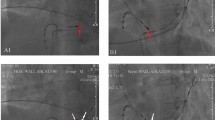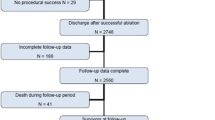Abstract
Verapamil-sensitive atrial tachycardia originating from the atrioventricular node vicinity (AVN-AT) can be eliminated with radiofrequency energy (RF) deliveries targeting either the entrance or exit of its reentry circuit. However, the outcome of these different approaches has not been clarified well. Thus, we compared the catheter ablation outcome targeting the entrance of reentry circuit, identified by the entrainment method (Ent-Group; 21 patients) with that targeting the earliest atrial activation site (EAAS) during AT (Exit-Group; 16 patients). There was no significant difference in the tachycardia cycle length (441.4 ± 87.4 vs. 392.8 ± 64.8 ms, p = 0.0704) or distance from the His bundle (HB) site to the EAAS (6.5 ± 2.0 vs. 7.6 ± 1.8 mm, p = 0.0822) between the Ent- and Exit-Groups. However, distance from the successful ablation site to the HB site in the Ent-Group was significantly longer than that in the Exit-Group (13.4 ± 3.1 vs. 7.6 ± 1.8 mm, p < 0.0001), resulting in more frequent transient atrioventricular block episodes in the Exit-Group than Ent-Group (31.3 vs. 0%, p < 0.01). Initial ATs (AT1s) were terminated in all patients in both Groups. However, ATs accompanied by shifting in the EAAS (AT2) were induced more frequently in the Exit-Group than Ent-Group (50.0 vs. 14.3%, p < 0.02) after eliminating AT1. RF deliveries to the EAAS eliminated all AT2s. The number of RF deliveries was greater in the Exit-Group than Ent-Group (6.9 ± 3.3 vs. 3.9 ± 1.6, p < 0.001). In conclusion, RF ablation targeting the entrance sites can avoid AVN injury and is superior in reducing the number of RF deliveries and occurrence of different ATs than targeting the exit sites in the AVN-AT.





Similar content being viewed by others
References
Iesaka Y, Takahashi A, Goya M, Soejima Y, Okamoto Y, Fujiwara H, Aonuma K, Nogami A, Hiroe M, Marumo F, Hiraoka M (1997) Adenosine-sensitive atrial reentrant tachycardia originating from the atrioventricular nodal transitional area. J Cardiovasc Electrophysiol 8:854–864
Yamabe H, Tanaka Y, Morihisa K, Uemura T, Enomoto K, Kawano H, Ogawa H (2010) Analysis of the anatomical tachycardia circuit in verapamil-sensitive atrial tachycardia originating from the vicinity of the atrioventricular node. Circ Arrhythm Electrophysiol 3:54–62
Lai LP, Lin JL, Chen TF, Ko WC, Lien WP (1998) Clinical, electrophysiological characteristics, and radiofrequency catheter ablation of atrial tachycardia near the apex of Koch’s triangle. Pacing Clin Electrophysiol 21:367–374
Yamabe H, Okumura K, Koyama J, Kanazawa H, Hoshiyama T, Ogawa H (2012) Demonstration of anatomical reentrant tachycardia circuit in verapamil-sensitive atrial tachycardia originating from the vicinity of the atrioventricular node. Heart Rhythm 9:1475–1483
Yamabe H, Kanazawa H, Ito M, Kaneko S, Kanemaru Y, Kiyama T, Tsujita K (2018) Slow potential at the entrance of the slow conduction zone in the reentry circuit of a verapamil-sensitive atrial tachycardia originating from the atrioventricular annulus. J Am Heart Assoc 7:e009223
Kaneko S, Yamabe H, Hoshiyama T, Kanazawa H, Ito M, Kanemaru Y, Kiyama T, Tsujita K (2019) Analysis of the preferable site and stability of rotational reentry: its role for the maintenance of atrial fibrillation. Heart Vessels 34:1014–1023
Nakatani Y, Sakamoto T, Yamaguchi Y, Tsujino Y, Kataoka N, Nishida K, Mizumaki K, Kinugawa K (2019) Impacts of the body size on the left atrial wall thickness and atrial fibrillation recurrence after catheter ablation. Heart Vessels 34:1351–1359
Yamabe H, Okumura K, Koyama J, Kanazawa H, Hoshiyama T, Ogawa H (2014) Demonstration of anatomic reentrant circuit in verapamil-sensitive atrial tachycardia originating from the atrioventricular annulus other than the vicinity of the atrioventricular node. Am J Cardiol 113:1822–1828
Yamabe H, Orita Y (2020) Demonstration of the anatomical tachycardia circuit in sinoatrial node reentrant tachycardia: analysis using the entrainment method. J Am Heart Assoc 9:e014472
Okumura K, Henthorn RW, Epstein AE, Plumb VJ, Waldo AL (1985) Further observations on transient entrainment: importance of pacing site and properties of the components of the reentry circuit. Circulation 72:1293–1307
Mann DE, Lawrie GM, Luck JC, Griffin JC, Magro SA, Wyndhan CRC (1985) Importance of pacing site in entrainment of ventricular tachycardia. J Am Coll Cardiol 5:781–787
Waldo AL, Plumb VJ, Arciniegas JG, MacLean WA, Cooper TB, Priest MF, James TN (1983) Transient entrainment and interruption of the atrioventricular bypass pathway type of paroxysmal atrial tachycardia. A model for understanding and identifying reentrant arrhythmias. Circulation 67:73–83
Heidbüchel H (2000) How to ablate typical “slow/fast” AV nodal reentry tachycardia. Europace 2:15–19
Satoh M, Miyajima S, Koyama S, Ishiguro J, Okabe M (1993) Orthodromic capture of the atrial electrogram during transient entrainment of atrioventricular nodal reentrant tachycardia. Circulation 88:2329–2336
Waldecker B, Coromilas J, Saltman AE, Dillon SM, Wit AL (1993) Overdrive stimulation of functional reentrant circuits causing ventricular tachycardia in the infarcted canine heart resetting and entrainment. Circulation 87:1286–1305
Anter E, Tschabrunn CM, Buxton AE, Josephson ME (2016) High-resolution mapping of postinfarction reentrant ventricular tachycardia: electrophysiological characterization of the circuit. Circulation 134:314–327
Martin R, Maury P, Bisceglia C, Wong T, Estner H, Meyer C, Dallet C, Martin CA, Shi R, Takigawa M, Rollin A, Frontera A, Thompson N, Kitamura T, Vlachos K, Wolf M, Cheniti G, Duchâteau J, Massoulié G, Pambrun T, Denis A, Derval N, Hocini M, Della Bella P, Haïssaguerre M, Jaïs P, Dubois R, Sacher F (2018) Characteristics of scar-related ventricular tachycardia circuits using ultra-high-density mapping: a multi-center study. Circ Arrhythm Electrophysiol 11:e006569
Ciaccio EJ, Coromilas J, Wit AL, Peters NS, Garan H (2018) Source-sink mismatch causing functional conduction block in re-entrant ventricular tachycardia. JACC Clin Electrophysiol 4:1–16
Schaeffer B, Stevenson WG (2018) Entrainment mapping: theoretical considerations and practical implementation. J Cardiovasc Electrophysiol 29:204–213
Anderson RH, Davies MJ, Becker AE (1974) Atrioventricular ring specialized tissue in the normal heart. Eur J Cardiol 2:219–230
McGuire MA, de Bakker JM, Vermeulen JT, Moorman AF, Loh P, Thibault B, Vermeulen JL, Becker AE, Janse MJ (1996) Atrioventricular junctional tissue. Discrepancy between histological and electrophysiological characteristics. Circulation 94:571–577
Yanni J, Boyett MR, Anderson RH, Dobrzynski H (2009) The extent of the specialized atrioventricular ring tissues. Heart Rhythm 6:672–680
Funding
None.
Author information
Authors and Affiliations
Corresponding author
Ethics declarations
Conflict of interests
The authors declare that they have no conflict of interest.
Additional information
Publisher's Note
Springer Nature remains neutral with regard to jurisdictional claims in published maps and institutional affiliations.
Rights and permissions
About this article
Cite this article
Yamabe, H., Kajiyama, K., Soejima, T. et al. Comparison of the catheter ablation outcome in patients between targeting the entrance and exit of the reentry circuit in verapamil-sensitive atrial tachycardia originating from the atrioventricular-node vicinity. Heart Vessels 36, 1201–1211 (2021). https://doi.org/10.1007/s00380-021-01791-5
Received:
Accepted:
Published:
Issue Date:
DOI: https://doi.org/10.1007/s00380-021-01791-5




